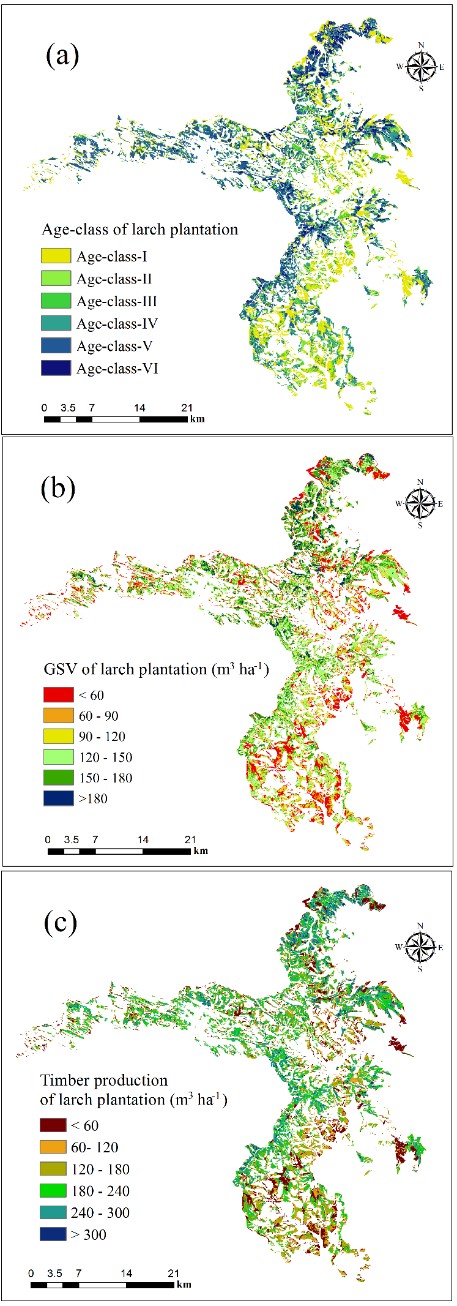Researchers in IAE Use MPT to Assess the Wood Production Of Forest Plantations During Management Process in History
Wood production is a major service function of timber productive plantation. Timber has been produced both during multiple thinning and by the final harvest. Former work focused only on Growing Stock Volume. The Historical Process-harvested Timber was often overlooked or not estimated.
Dr GAO Tian in the Secondary Forest Ecology and Management Research Group, IAE and his co workers took the larch plantations in Saihan Dam National Forest Park ( where there is over 43,946 ha larch plantations) as example,using optic/radar image,combined with data from ground survey and historic record in thinning intensity,cutting interval and rotation period, designed a Management Process–based Timber production framework- MPT and parameters taken from random stands: stock volume and age class, assessed the historical timber production in the process of plantation management .
The results show that during the period 1962-2010, Saihanba Forest Farm had a total timber production 7.27 million m3 including current stock volume 4.87 and harvested in he history 240m3. This means about 1/3 timber production has been overlooked in the earlier assessment. The new idea in the design of MPT framework is a break through to the traditional method in evaluation timber production based only on current stock volume / biomass, resolved a long-term problem that the historical timber produced in the management process.
The results were published in International Journal of Applied Earth Observation and Geoinformation, entitled as Timber production assessment of a plantation forest: An integrated framework with field-based inventory, multi-source remote sensing data and forest management history. The work was supported by a 973 project (2012CB416900).

Figure 1. A management process–based timber production framework for larch plantation of SFC. TO refers to thinning operation. (Image by Gao Tian , Institute of Applied Ecology Chinese Academy of Sciences)

Figure2. Spatial patterns of estimated age-classes (a) and GSV (b); Spatial patterns of timber production assessed by the management process–based timber production framework (c).(Image by Gao Tian , Institute of Applied Ecology Chinese Academy of Sciences)
Full text URL: http://www.sciencedirect.com/science/article/pii/S0303243416300861#rpctoken=931172808
Abstract: Timber production is the purpose for managing plantation forests, and its spatial and quantitative information is critical for advising management strategies. Previous studies have focused on growing stock volume (GSV), which represents the current potential of timber production, yet few studies have investigated historical process-harvested timber. This resulted in a gap in a synthetical ecosystem service assessment of timber production. In this paper, we established a Management Process–based Timber production (MPT) framework to integrate the current GSV and the harvested timber derived from historical logging regimes, trying to synthetically assess timber production for a historical period. In the MPT framework, age-class and current GSV determine the times of historical thinning and the corresponding harvested timber, by using a “space-for-time” substitution. The total timber production can be estimated by the historical harvested timber in each thinning and the current GSV. To test this MPT framework, an empirical study on a larch plantation (LP) with area of 43,946 ha was conducted in North China for a period from 1962 to 2010. Field-based inventory data was integrated with ALOS PALSAR (Advanced Land-Observing Satellite Phased Array L-band Synthetic Aperture Radar) and Landsat-8 OLI (Operational Land Imager) data for estimating the age-class and current GSV of LP. The random forest model with PALSAR backscatter intensity channels and OLI bands as input predictive variables yielded an accuracy of 67.9% with a Kappa coefficient of 0.59 for age-class classification. The regression model using PALSAR data produced a root mean square error (RMSE) of 36.5 m3 ha?1. The total timber production of LP was estimated to be 7.27 × 106 m3, with 4.87 × 106 m3 in current GSV and 2.40 × 106 m3 in harvested timber through historical thinning. The historical process-harvested timber accounts to 33.0% of the total timber production, which component has been neglected in the assessments for current status of plantation forests. Synthetically considering the RMSE for predictive GSV and misclassification of age-class, the error in timber production were supposed to range from ?55.2 to 56.3 m3 ha?1. The MPT framework can be used to assess timber production of other tree species at a larger spatial scale, providing crucial information for a better understanding of forest ecosystem service.
Publication Name: Gao Tian, Zhu Jiaojun, Deng Songqiu, Zheng Xiao, Zhang Jinxin, Shang Guiduo, Huang Liyan.
Email: tiangao@iae.ac.cn.



